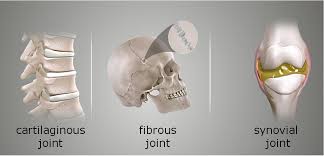Human Bio T2 W1
1/19
Earn XP
Description and Tags
Flashcards reviewing the types of joints based on notes.
Name | Mastery | Learn | Test | Matching | Spaced |
|---|
No study sessions yet.
20 Terms
Articulation (Joint)
Point where two bones meet, allowing varying degrees of movement and stability in the skeletal system.

Functional Joint Classification
Based on the amount of movement.
Structural Joint Classification
Based on the type of connective tissue that binds the bones together and whether a joint cavity is present.
Fibrous Joint
Bones are held in place by fibrous connective tissue; no joint cavity is present; mainly found in the axial skeleton.
Cartilaginous Joint
Bones are held in place by fibrocartilage, allowing slight movement; no joint cavity is present; mainly found in the axial skeleton.
Synovial Joint
Contains a fluid-filled synovial cavity, enclosed in a fibrous capsule, between articulating bone surfaces, allowing free movement.
Fibrous
Structural classification for Fibrous Joint
Fixed/immovable
Functional classification for Fibrous Joint
Cartilaginous
Structural classification for Cartilaginous Joint
Slightly movable
Functional classification for Cartilaginous Joint
Synovial
Structural classification for Synovial Joint
Freely movable
Functional classification for Synovial joint
Why are synovial joints (freely moveable joints) called synovial
Cause they have a synovial cavity (joint cavity) between articulating bone surfaces
What do synovial joints consist of
Articular capsule that encloses the joint with a outer layer called fibrous capsule and inner layer called synovial membrane, which secretes synovial fluid.
A synovial cavity that consists of synovial fluid.
Articular cartilage covering the ends of the bones.
How is joint stability achived
The fit of articulating bones (e.g. femur head fitting into pelvis socket).
Strength of joint ligaments
Tension provided. by surrounding muscles and tendons.
How are synovial joint classified
Their range of motion includes non-axial (no plane), uniaxial (1 plane), biaxial (2 planes), and multi-axial (3 planes) types.
Non axial synovial joint
A type of joint that allows for gliding movements without rotating, having no distinct axis of rotation such as gliding joints (parts of wrist and ankle bones).
Uniaxial synovial joint
A joint that allows movement around one axis, such as hinge joints (e.g., elbow) or pivot joints (e.g., neck).
Biaxial synovial joint
A joint that permits movement around two axes, enabling motion in two planes, such as saddle joints (e.g., thumb) and condyloid joints (e.g., wrist).
Multi axial synovial joint
A joint that allows movement around multiple axes, facilitating a wide range of motion in several planes, such as ball-and-socket joints (e.g., shoulder and hip).